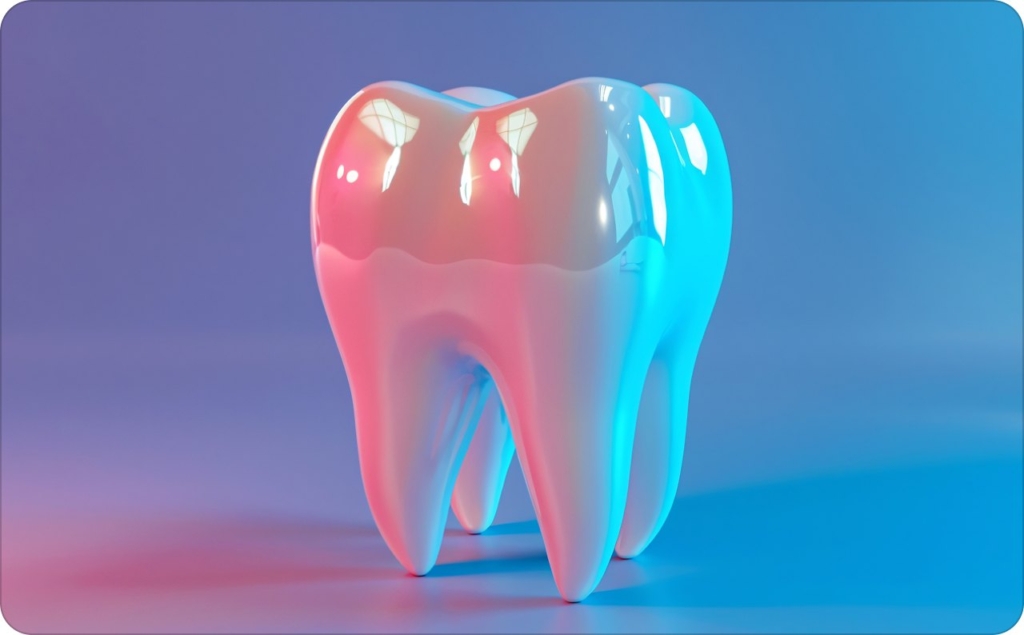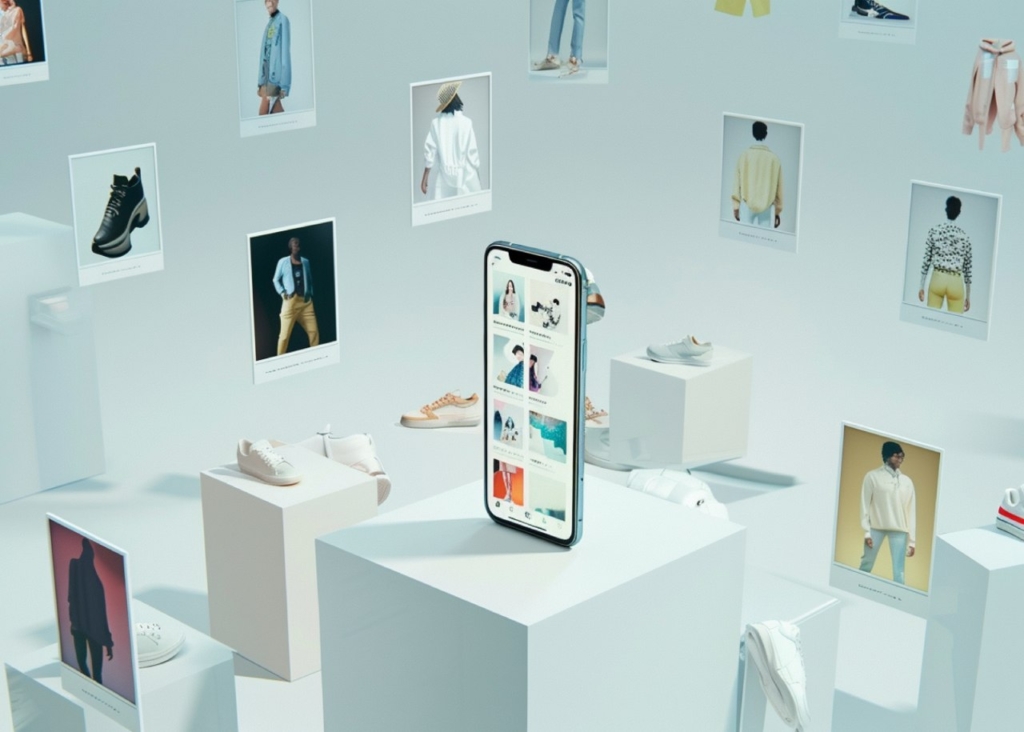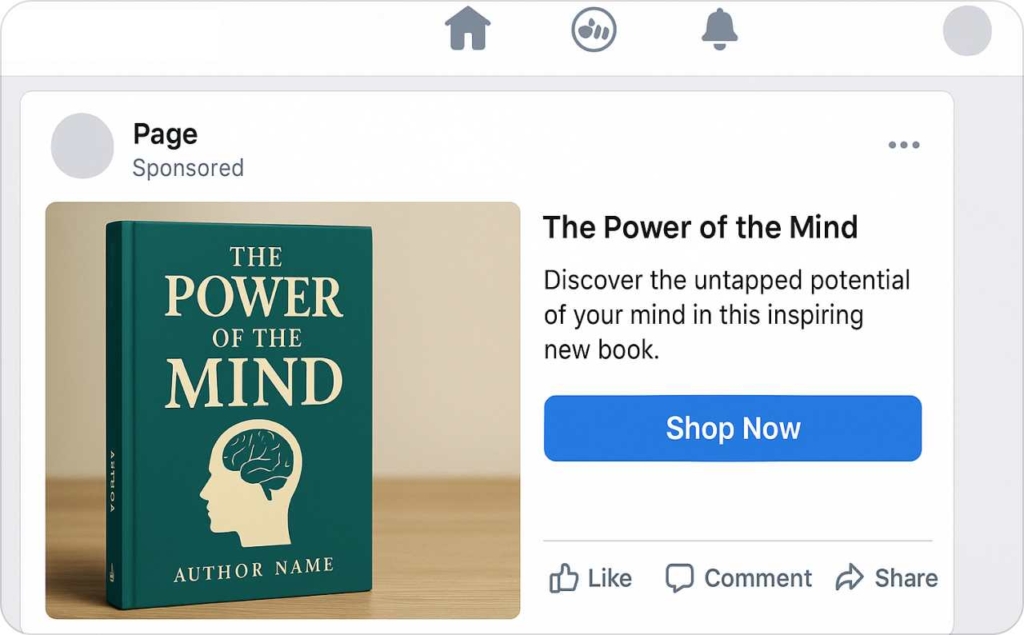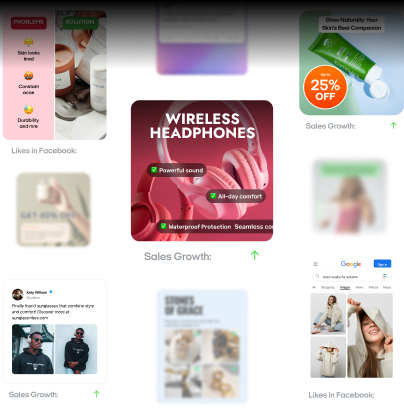UGC video ads for e-commerce: How to boost conversions by 161%
What if your customers could sell for you? Discover how UGC video ads are driving up to 161% higher conversions for e-commerce brands.
Running ads that look great but barely convert? You might be speaking the wrong language to your audience.
Today’s shoppers don’t want polish. They want proof. Real people, real results, and relatable moments. That’s why UGC video ads are the key to better ROI and outperforming traditional campaigns across TikTok, Instagram, and Meta.
In this blog post, you’ll learn how to use user-generated video ads to build trust, drive clicks, and increase conversions — without spending a fortune or hiring influencers.
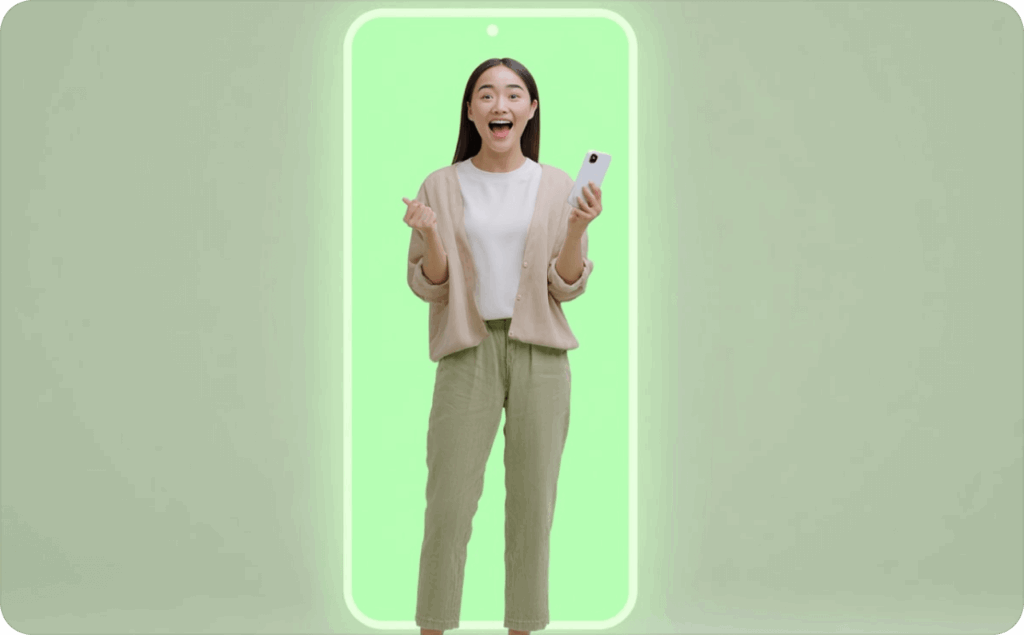
How UGC video ads work?
UGC video ads are short clips made by real customers who already use your product. They look more genuine than traditional ads because everyday people film them at home using their phones.
You’ll often find these user-generated videos on platforms like Shopify or WooCommerce. According to Commerce Pro on UGC, these ads can boost engagement by up to 60%. That means more people clicking, sharing, and trusting what they see.
You don’t need traditional ads that are scripted, polished, and expensive to produce. The Whatmore AI Blog on UGC shows that raw, honest footage builds stronger buyer confidence. When shoppers see other customers using your product, they relate. It feels real, not staged.
Here’s the difference: UGC video ads feel like word-of-mouth. A real person shares a story or review. That’s what new buyers want to see. When your fans post an unboxing video, a quick demo, or a short product review, people watching think, “That could be me.”
These videos tell a true story. They use authentic storytelling that regular people understand. You’re not pushing a sale — you’re sharing a customer-driven narrative. That makes your brand more human and easier to trust.
Using UGC for e-commerce also helps you cut ad costs. You don’t need a big team or pro gear. You let your happiest customers speak for you. That kind of genuine user content helps you connect with new buyers and build loyalty.
In today’s crowded e-commerce marketing space, being relatable matters. When people hear real voices, they trust your product. And when they trust you, they buy.
Why UGC video ads help your store sell more
If you run an online store, you want ads that build trust and sell more products. That’s exactly what they can do. UGC video ads play an important role in advertising — they help you boost conversion rate, increase brand engagement, and build social proof faster than expensive studio promos. Let’s see how.
How UGC video ads boost your conversions
Want more people to buy? Show them real users.
HubSpot says 90% of consumers trust user-generated content, it has a bigger impact on their buying decisions than promotional emails or even search results. Why? Because people trust people more than brands.
Let’s break it down.
Imagine you run a skincare brand. You post a professionally shot video showing the product benefits. Nice, but polished. Now compare that to a 25-year-old customer filming a 30-second “before and after” reel using her phone. Her video gets 4x the views and 2x the saves. That’s not just better engagement —it’s conversion power.
Glossier built a $1.2 billion brand by doing just that. Instead of pushing ads, they let customers become the marketers. Reviews, tutorials, and everyday selfies became their best-performing content. Many e-commerce brands see up to 161% higher conversion rates when they add UGC to product pages and paid ads.
Now that you’ve seen how UGC drives purchases, let’s talk about how it helps shoppers feel more confident along the way.
UGC stops buyer hesitation with real customer videos
Most people leave a site without buying. Why? Doubt. Will this product work for me? What if it looks different in real life?
That’s where UGC steps in.
Adweek found that 58% of Gen Z buyers said they bought beauty, wellness, or health products because they saw UGC. Not ads. Not influencers. Real customers like them.
Say you sell wireless earbuds. A customer uploads a short TikTok showing how they stay put during a run and how crisp the audio sounds. That’s not marketing—it’s purchase confidence in motion.
UGC helps buyers see someone like them using your product in real life. And that alone can erase hesitation.
Let’s take that confidence and build on it — through the power of social proof.
Gain trust with social proof
Social proof is what happens when people think: “If others are buying this, maybe I should too.” And nothing builds that faster than UGC.
As Social Media Examiner puts it, UGC shows potential buyers that “people like them” are already shopping your brand. That visibility reduces uncertainty and adds trust.
Take GoPro as an example. Their entire marketing strategy is built on UGC. Skydivers, surfers, hikers film their wild moments using a GoPro, and the brand turns those clips into ads. No scripts. No actors. Just powerful peer recommendations in action.
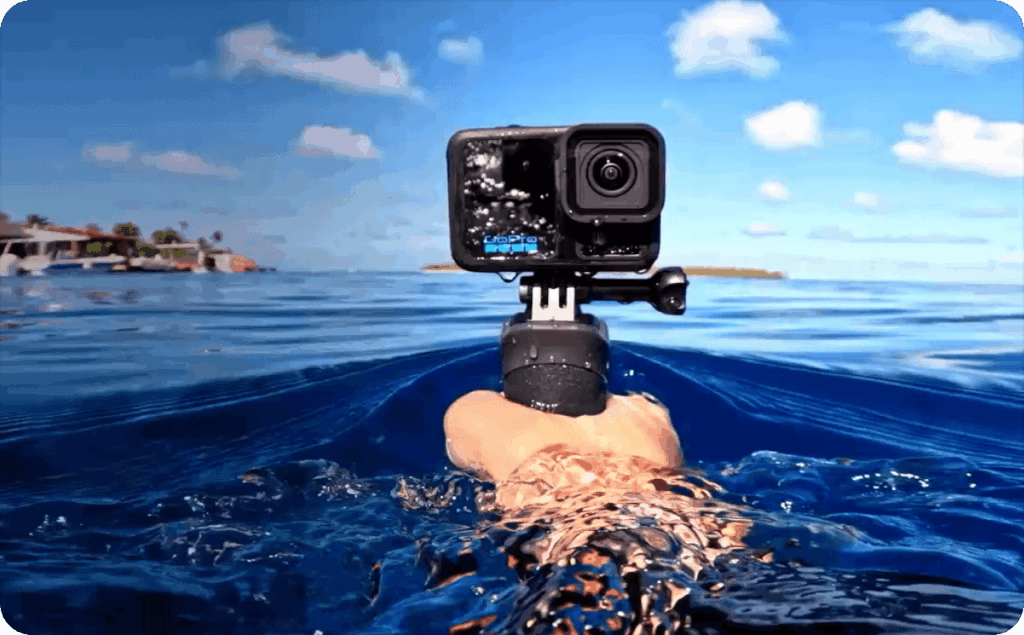
Photo source: GoPro
Even if your brand is small, the same approach works. Highlight real customers. Repost reviews. Let shoppers do the storytelling — and turn browsers into believers.
And if you want to create that kind of trust without paying influencer rates, the next section is for you.
Use influencer-style UGC without breaking your budget
You don’t need influencers with 1 million followers to make an impact. You need real users with real stories.
Influencer-style UGC happens when your everyday customers talk to the camera, walk through their results, or share “here’s why I love this” moments. It feels personal but you don’t have to spend thousands.
Let’s say a customer shares a short Instagram Reel of how your fitness tracker helped them hit their goals for the month. You repost that video in an ad. The result? Higher watch time, better comments, and more clicks.
That’s authentic endorsement at work — and it costs you nothing but a little customer love.
Now let’s look at what happens when UGC does more than convert — it grows your reach.
Grow brand awareness with authentic content
Brand awareness starts with attention. And UGC content gets a lot of it.
UGC video ads receive 10x more views than traditional branded content. Platforms like TikTok and Instagram push native-looking content that blends into the feed. Your customers’ content fits that mold — without the production bill.
Say you run an apparel brand. A shopper posts a 15-second video showing how your hoodie fits after a wash. She tags you. You repost it as a paid ad. That single clip introduces your brand to thousands of new viewers.
Every share builds reach. Every repost boosts visibility. And every tag creates a path back to your brand.
But sometimes, UGC doesn’t just raise awareness — it goes viral.
Spark viral success through UGC
UGC videos have a natural advantage most ads can’t touch — they spread on their own.
When your customer’s video is funny, helpful, or emotional, it’s more likely to be shared. That’s how one person’s story can reach thousands or even millions.
Encourage your buyers to tag your brand or use a branded hashtag. Repost your favorites. Feature them in email campaigns, Instagram Stories, or TikTok ads. This builds a feedback loop that amplifies your brand every time someone shares.
You can’t always plan for viral success — but with UGC video ads, you give yourself a shot at it every day.
5 smart video ad ideas from your customers that actually work
If you want unstoppable e-commerce growth, you can’t rely on brand-fed ads alone. UGC video content bridges the gap between trust and authenticity, turning everyday shoppers into your most compelling marketers.
Earn trust with product reviews and testimonials
Product reviews give shoppers exactly what they’re looking for: proof. A short, unscripted video from a real customer can go further than a high-budget promo.
Want to start simple? Reach out to a few happy customers. Ask for a short clip about how your product helped them. You can place those testimonials next to product descriptions or turn them into ad creatives.
Brands like Kiko Milano use tools like Walls.io to stream video reviews alongside product features, turning social proof into a shopping driver.
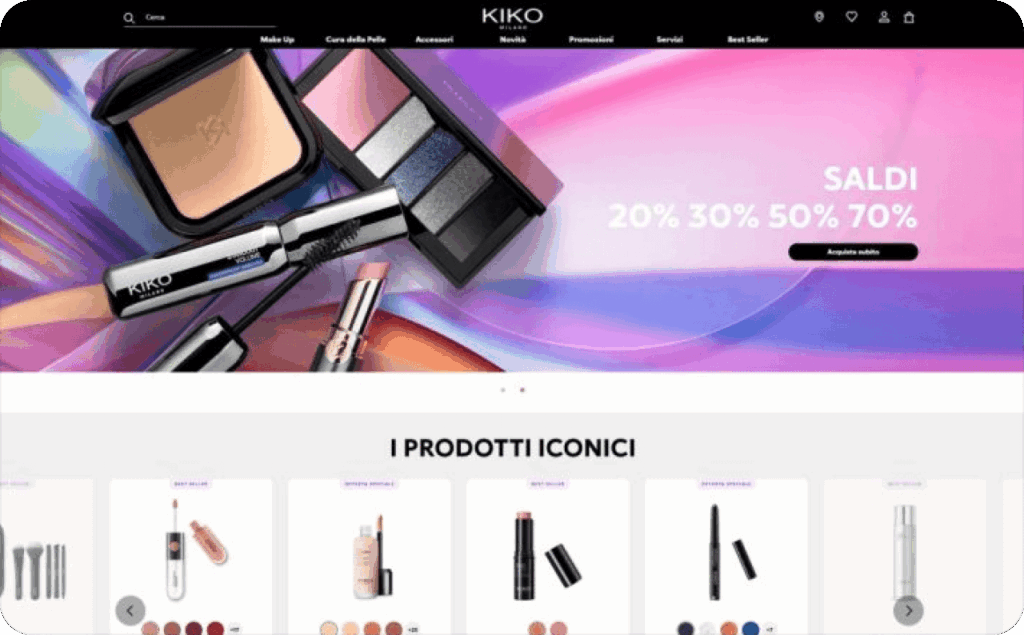
Excite shoppers with unboxing videos
Unboxing content taps into the excitement of “what’s inside.” It shows off your packaging, product quality, and customer delight — all in under a minute.
Even virtual platforms like Roblox understand this power. They’ve built a creator economy around the thrill of buying and unwrapping digital goods.
You can capture the same energy. Include a thank-you note in your packaging asking customers to film their unboxing. When they post it, share it. A real reaction from a real buyer makes future customers feel more confident clicking “buy now.”
Show them tutorials and how-to videos
UGC tutorials show — not just tell — how your product fits into everyday life. They answer the exact question on a buyer’s mind: “How does this actually work for me?”
Take a kitchen brand, for example. A short video of a customer blending a smoothie or meal-prepping lunch with your product simplifies the decision process. It’s practical, relatable, and builds trust.
Platforms like Fortnite reward creators who make high-quality experiences, proving that empowering your users with helpful content leads to loyalty.
To start, record a simple how-to or share a customer’s demo. It doesn’t need polish — it needs to be clear, honest, and useful.
Create buzz through social media challenges
Social challenges let your audience do the marketing for you. They’re fun, participatory, and perfect for community building. Just look at Apple’s #ShotoniPhone campaign or the UN’s #GenerationRestoration movement — both turned everyday people into storytellers, pushing their message across platforms.
You can follow that same formula. Pick a theme. Create a hashtag. Offer a small reward or just repost the best content. Use a platform to display challenge entries on your site or during live events.
Reach more buyers with influencer collaborations
Partnering with influencers brings built-in trust and reach. But you don’t need big names. Micro-influencers are creators with 5K–50K followers. They often drive more engagement because their audiences feel personal and tight-knit.
Let’s say you sell handmade jewelry. Reach out to influencers who already post about slow fashion or sustainable shopping. Offer a free product and let them post in their voice.
Just like Fortnite’s creator program, which shares 40% of revenue with game-makers, you can reward creators with affiliate codes, early access, or exclusive drops. The key is letting them stay authentic.
Every UGC video ads type — reviews, unboxings, how-tos, challenges, and collaborations — adds a different kind of value to your brand. Use them together to create content that feels real, builds community, and drives results. No studio setup required.
Build your UGC video ad strategy
If you’re running an online store, UGC video ads aren’t just a trend — they’re a smart way to boost sales and build trust. They show real customers using your product in real life. That makes your brand feel honest, not scripted.
Let’s talk about how to get started.
Step 1. Start by choosing one goal. Do you want to build trust? Then begin with product reviews or customer testimonials. Need to explain your product better? Try a how-to UGC video.
Want more reach? A social media challenge might be your best move. Pick one format that fits your audience and solves a problem.
Step 2. From there, begin collecting content. Ask your best customers to share short videos.
If you need more, tools like Zeely AI make it easy to start a UGC video ad campaign with short clips from real users. Platforms like Tagshop turn your community’s content into shoppable UGC galleries.
Step 3. Next, think about where to use your content. Place your videos on product pages to reduce doubt. Add them to email flows for better clicks.
Run them in paid ads to boost engagement. You can even add them to a social wall using platforms like Walls.io.
Step 4. To increase submissions, offer a small reward. A discount code or a repost on your brand’s page can go a long way.
Step 5. Track your results. Look at views, clicks, and purchases. Then refine your UGC strategy based on what’s working.
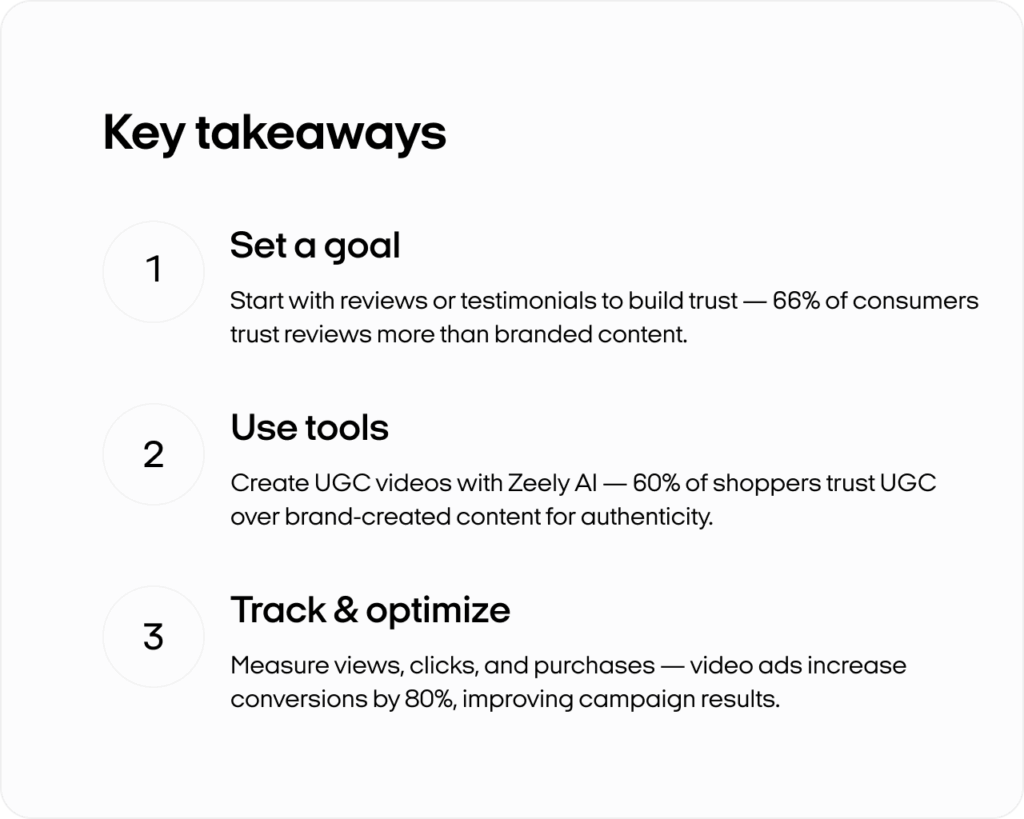
Zeely AI: Your one-stop platform for UGC video ads
If you want to create viral UGC-style video ads quickly, Zeely AI can help. It’s designed as an AI copilot for your e-commerce marketing.
You can produce multiple ads in minutes, manage entire ad campaigns, and optimize performance without using different tools.
Produce UGC videos in minutes, not days
One major benefit is speed. You can go from no video production to a fully rendered UGC video in about 20 minutes. That’s a fraction of the time you’d spend on traditional methods. You’ll save money while raising your brand visibility.
If you need more than one ad, bulk creation lets you generate multiple ads at once. This is especially useful for A/B testing or rolling out different messages to your audience.
Speak to your customers with AI avatars
Some business owners don’t want to be on camera. Zeely solves that by offering 30+ hyper-realistic avatars who speak and act like real people.
Pick one that suits your brand voice, and the avatar can use sales-focused scripts built on proven marketing methods like AIDA and PAS. This ensures your UGC video ads feel both real and conversion-focused.

Create videos without technical skills
Dynamic templates add smooth transitions and performance-focused elements to your ads. You don’t need a background in design — just paste your product link and let Zeely AI do the rest.
If you prefer static ads, choose from 100+ proven templates. Each template comes with built-in AI copywriting to optimize headlines, CTAs, and visuals.
Create, test, and refine in one place
Zeely helps you test and refine every ad. Use A/B testing and real-time data to see what works best. Then, scale faster and boost your ROI by improving each version of your campaign.
Whether you want to start a UGC video ad campaign or just need a simpler way to manage marketing, Zeely AI is a user-friendly choice that covers it all.
The bottom line
User-generated content works because it’s real. It builds trust. It drives action. When you use the voices of your actual customers, your store feels more human — and that’s what makes people buy.
Also recommended
